Pet friends of Tulalip tribal members and employees get in the Halloween spirit.
syəcəb
Pet friends of Tulalip tribal members and employees get in the Halloween spirit.
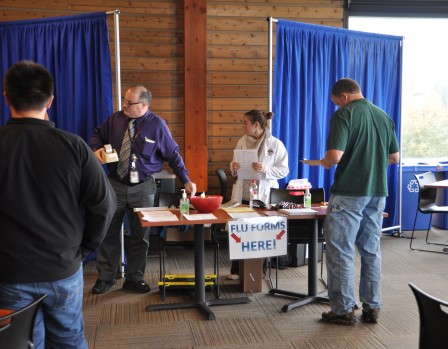
By Monica Brown, Tulalip News Writer
TULALIP, Wash. – Flu season is here and if you want to prevent from getting the flu or contributing to spreading it, the flu vaccine is the way to go. Today, Oct. 22nd, from 12:00 to 3:00pm at the Tulalip Admin building, the Tulalip Pharmacy is issuing flu vaccines on the second floor in the lunch area. For non-tribal members please bring your medical insurance information.
The Center for Disease Control recommends that all those who are able to be vaccinated do so. Listed below is some information from the CDC about how the vaccine works and who should consider getting vaccinated.
How do flu vaccines work?
Flu vaccines cause antibodies to develop in the body about two weeks after vaccination. These antibodies provide protection against infection with the viruses that are in the vaccine.
The seasonal flu vaccine protects against the influenza viruses that research indicates will be most common during the upcoming season. Traditional flu vaccines (called trivalent vaccines) are made to protect against three flu viruses; an influenza A (H1N1) virus, an influenza A (H3N2) virus, and an influenza B virus. In addition, this season, there are flu vaccines made to protect against four flu viruses (called “quadrivalent” vaccines). These vaccines protect against the same viruses as the trivalent vaccine as well as an additional B virus.
While everyone should get a flu vaccine this season, it’s especially important for some people to get vaccinated.
Those people include the following:
By Bill Sheets, The Herald
EVERETT — While a decision on whether tidal power turbines may be installed in Admiralty Inlet has been delayed in part by the federal government shutdown, sparring between the proponent and opponents has continued.
The Federal Energy Regulatory Commission had planned to decide whether to approve the Snohomish County Public Utility District’s $20 million tidal power pilot project as early as this past summer, but now it will likely wait at least until December, according to the utility.
The federal energy agency has been awaiting a report on the project from the National Marine Fisheries Service. Completion of that report came later than expected and has been further delayed by the government shutdown, PUD officials said.
The tidal power plan has faced stiff opposition from Pacific Crossing of Danville, Calif., which owns two transoceanic cables that run through the inlet between Whidbey Island and Port Townsend.
Four Indian tribes, including the Tulalips, also say the project could affect salmon migration and fishing.
Officials with the PUD say the concerns either are unfounded or have been addressed. A 215-page environmental study issued last year by the FERC concluded that the turbines pose no threat to the cables, wildlife habitat or fishing.
Under the plan, two 65-foot-tall turbines, each resembling a giant fan sitting on a tubular platform, would be placed 200 feet underwater to capture the current. The turbines are made by OpenHydro of Ireland.
At peak output, the turbines are expected to generate 600 kilowatts between them, enough to power 450 homes. Most of the time, the output will be less, PUD officials say. This would be a demonstration project intended to determine whether more turbines could be effective in the future, officials say.
The cables, only a couple of inches in diameter, contain fiber-optic lines that transmit data through the Internet and social media, said Kurt Johnson, chief financial officer for Pacific Crossing. The lines are encased in steel and polypropylene.
The cable network extends a total of more than 13,000 miles in a loop from Harbour Pointe in Mukilteo to Ajigaura and Shima, Japan, and Grover Beach, Calif.
The turbines would be placed about 575 feet and 770 feet from the cables. Pacific Crossing and its trade group, the New Jersey-based North American Submarine Cable Association, say the standard should be around 1,600 feet.
Pacific Crossing has submitted several more sets of comments to FERC since last winter.
The cable interests believe the lines could be damaged by placement of the turbines or by boats dropping anchors in the area.
“Our ultimate concern is the adequate and safe separation of the turbines from our cables,” Johnson said. “We’re kind of concerned this project will become a precedent for authorizing projects such as this at an unsafe distance from submarine cables.”
The company pointed out that an agreement between utilities and cable companies in the United Kingdom established 500 meters — about 1,600 feet — as the minimum distance between offshore wind farm turbines and undersea cables.
On its website, the cable association says that although the agreement pertains to wind projects, the agreement could be applied equally to tidal and wave energy projects.
Officials with the PUD disagree.
“The bottom line is it’s an apples and oranges kind of thing,” said Craig Collar, assistant to PUD general manager Steve Klein.
The PUD earlier submitted to the federal agency a list of precautions that crews would take when operating near the turbines. For example, boats would stay running when in the area to eliminate the need for dropping an anchor, Collar said.
On the issue of turbine placement, OpenHydro officials have told those at the PUD that they can get the turbines within 10 feet of their target locations, Collar said.
In response to the environmental study, the Tulalip Tribes, the Suquamish Tribe and the Point No Point Treaty Council, representing the Port Gamble and Jamestown S’Klallam tribes, each sent letters disputing its conclusions.
Fishing gear could get hung up in the turbines, and the structures could potentially harm migrating salmon, said Daryl Williams, environmental liaison for the Tulalip Tribes.
Tribes fish for halibut, crab and shrimp in the area, he said.
“We’ve already lost most of our fishing area due to shipping traffic and piers and anchor buoys and the other things that get in the way of drift gillnets,” Williams said.
The turbines take up but a tiny part of the large inlet, Collar said.
“This project is so small, it doesn’t in any material way impede the tribes’ fishing rights,” he said.
Williams said the very conditions that determined the placement of the turbines — strong currents — could steer migrating salmon into the turbines. Chinook salmon and sturgeon travel as deep as 150 feet below the surface, he said.
“When the fish are migrating, they travel with the current so they don’t burn much energy while swimming,” Collar said. “We don’t think the studies are going to identify what the impacts are to migrating fish.”
The PUD is working with the University of Washington on state-of-the-art sonar equipment and underwater cameras that will be deployed to monitor fish passage near the turbines.
The tribes are skeptical, Williams said.
“Our fish are already in bad shape in the Puget Sound area and we’re throwing in one more obstacle to recovery.”
Diabetes day at the Tulalip Health Clinic
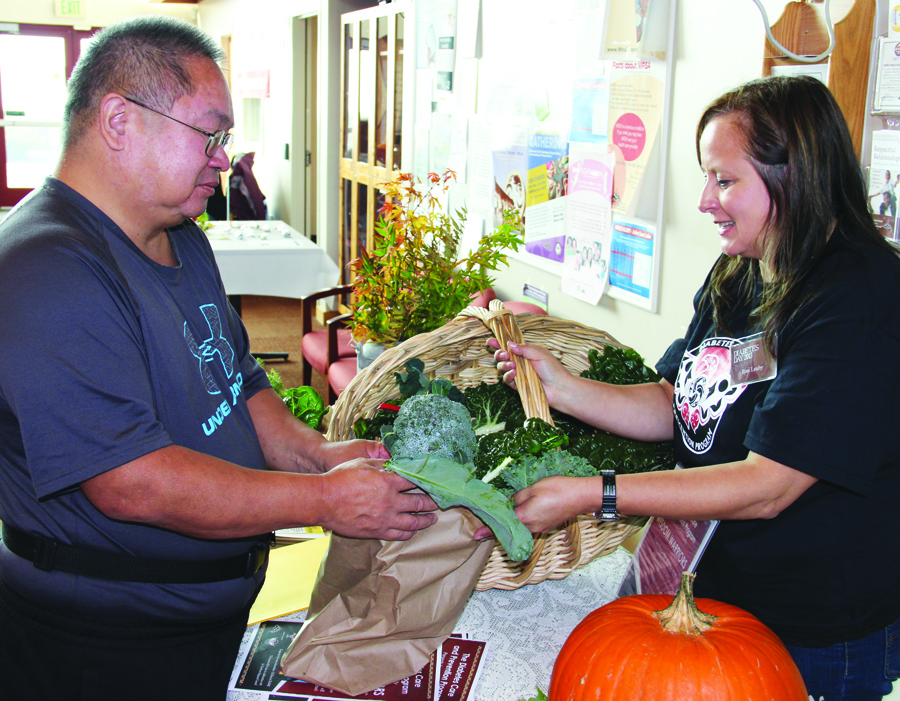
By Andrew Gobin, Tulalip News
“Rather than making multiple appointments throughout the week, today we have made available every service for diabetes testing all at once,” said Bryan Cooper about the October 15th diabetes day at the Tulalip Karen I. Fryberg Health Clinic. A day meant to inform about the disease also offers tips on diabetes prevention, healthy living, and general nutrition.
Cooper, the medical director at the clinic, made key points as to why diabetes day is a success, such as explaining the ease of diabetes testing, both for patients and staff.
“Our labs are nationally accredited. Here at the clinic, lab results are ready in 15 minutes, which is unheard of at larger clinics and hospitals.”
Although Cooper is one of the lead organizers, he emphasized the importance of the team of specialists that make diabetes day possible. “The team made themselves available, making it possible to have integrated services to streamline diabetes testing. That was one concern we kept hearing from patients, that testing was too time consuming, spanning multiple days and appointments,” said Cooper. “Today, patients can come in and get everything done at once, and it doesn’t take long to make it through each necessary station.”
Diabetes day is one aspect of a five-year plan developed last summer to create programs at the clinic geared towards community needs. Diabetes day began January of this year, and it happens 4 times a year, to allow for the convenient service for new patients, as well as those diabetic patients that need to be seen every 3 months. The staff would really like to see the clinic become a place for the community wellness center, where people could come and relax and visit, not just for medical needs.
“In addition to dental and medical, we offer alternative medicine such as acupuncture, reiki, bowen, massage, chiropractor, and traditional healing. We have a garden of traditional foods available to patients as well,” said Cooper.
Visit the clinic to learn more about upcoming events and programs, or to learn more about any of these services provided.
Guests can kick off game day with dishes like Curve Ball Shrimp and the Formula 500 Walla Walla Onion Tower. Signature plates include Grand Slam Chili; The Hook Crispy Mahi Mahi Filets and Fries; TKO Mac and Cheese Skillets; and a juicy BBQ Hog Handwich. No sports bar would be complete without a juicy Hall of Fame Cheeseburger, where guests design their own. When both the finish line and the finish of the meal are in sight, fans can cruise the “Sweet Victory” dessert menu of Fried Seasonal Pie served in an iron skillet with a big scoop of vanilla ice cream; or the Overkill Sundae with peanut butter ice cream, sliced banana, milk chocolate magic shell, rice crispy treat nuggets and toasted peanuts. Also available is a “Quick Picks” menu which will offer nine signature items from The Draft, for take-out.
The Draft is open Sunday – Saturday from 4pm – 2am, serving the full menu from 4pm – 10pm, and a late night menu from 10pm – 1am. Quick Picks take-out will be offered daily from 11am – 11pm, starting October 7th. For more information, visit www.tulalipresort.com. To make reservations, call The Draft at 360-716-6333, or for Quick Picks to go option call 360-716-633.
Destination Lounge
Candle light and fire inspired the Resort’s new hotel lobby bar “Destination Lounge”. The atmosphere plays on light through motion and reflection. Small niches are filled with antique mirrors, clustered candles and sconces — which illuminate through gold petals. A large peninsula three sided fireplace adds movement and echoes a layer of warmth throughout the space. Large comfortable, high-back banquettes, which line the wall, are adorned with sexy, shimmery gold upholstery and flame red lounge chairs bring the space to life. Behind the glow of the knife-edged stone bar, is a custom etched antique mirror with a red Salish graphic. Rich espresso stained wood walls and the herringbone patterned floor wrap the space, while jazz musicians hold center stage on the four high definition televisions.
Resort guests can relax over handcrafted cocktails like the Spicy Cucumber, Moonshine Special, Geo-Mandarin Strawberry, Polka Dot or a new twist on the classic Sazerac. The appetizer menu features dishes such as Shrimp Thai Basil Pesto Spring Rolls, Cedar Wrapped Salmon Bites and Herb Polenta French Fries.
Destination Lounge is open seven days a week from 4pm – 10pm, offering seasonal appetizers, handcrafted cocktails, and an extensive wine selection by the glass or bottle. For more information, visit www.tulalipresort.com, or call (360) 716-6000.
By Wayne Kruse, The Herald
The answer, deer hunters, is “yes.” And the question is: Are we allowed to hunt on national forest land this weekend?
With the federal government shutdown still in place as of Wednesday, and U.S. Forest Service personnel on furlough, it wasn’t possible to get a live federal opinion on whether or not hunters would be welcome on federally managed land for the modern firearm deer opener on Saturday. But state Fish and Wildlife Department enforcement captain Mike Hobbs, at the agency’s Mill Creek office, said that in his opinion, unless you’re faced with a locked gate or signage specifically denying entry, you’re good to go.
And with that out of the way, here’s a quick rundown on prospects for the 2013 hunting seasons in selected parts of the state:
Okanogan County mule deer: A real bright spot in Washington’s deer-hunting picture this year, according to district wildlife biologist Scott Fitkin. The Okanogan supports Washington’s largest migratory mule deer herd, has excellent public access, and has long been arguably the most popular hunting area for mulies and a few whitetail.
This year should provide a good hunt, Fitkin said, following three consecutive winters of above average fawn recruitment. Hunters should see moderate numbers of younger bucks but — and here’s the big draw this year — the best population of older bucks in a long time.
A survey last year showed 34 bucks per 100 does, the highest ratio in decades, and an indicator of excellent buck carryover. Fitkin said summer forage conditions were favorable, so deer should be in top physical condition this fall.
Permits and regulations are about the same as last year, which produced a harvest 13 percent better than 2010. The top total harvest was in Game Management Unit 204, with its 50-50 population of whitetail and mule deer, but GMUs 215, 218, 224 and 233 also were good. Those five units produced 75 percent of the county’s deer harvest in 2012.
Southwest Washington blacktail: Several units here are almost always tops in the state for blacktail. The highest general season harvest last year was in GMUs 501 (Lincoln), 520 (Winston), 530 (Ryderwood) and 550 (Coweeman). The better hunting by far, according to state district biologist Pat Miller, is during the late portion of the general season or during the late buck hunt, when wind and rain have dampened and knocked down thick foliage.
Some of the better hunting occurs on private forest land, which can be researched on the Department of Fish and Wildlife’s Private Lands website, page 96 of the hunting regulations pamphlet or at the state’s Go Hunt mapping website. Weyerhaeuser’s phone number is 1-866-636-6531; the Cowlitz Valley Ranger District office is 360-497-1100; and the Castle Rock Department of Natural Resources office is 360-577-2025.
Southwest Washington elk: The area is usually No. 1 or 2 in the state for elk hunting success rates, according to biologist Miller. The best units last year were 506 (Willapa Hills), 520 (Winston), 530 (Ryderwood), and 550 (Coweeman). Permit elk hunters took 1,458 elk in 2012, while general season hunters harvested 1,728 animals.
Columbia Basin birds: Grant County is traditionally the best place in the state to hunt ducks, geese and pheasant, and because the harvest has been fairly consistent over the past 10 years, this season should be no different.
The highest population of wild pheasant (Eastern Washington pheasant season doesn’t open until the Oct. 19), according to district biologist Rich Finger in Ephrata, is around the Frenchmen and Winchester wasteways, between Potholes Reservoir and the town of George. Mixed bags of wild and released pheasant can be found along lower Crab Creek, around the Gloyd Seeps, and in the Quincy and Dry Falls areas.
Don’t always zero in on the release sites, Finger says. Data show that released birds made up only a quarter of the pheasant, at most, taken in the county in 2012.
Pheasant tips: Move fast and cover a lot of ground; use non-toxic shot and diversify your bag with waterfowl; try the pheasant release sites (go to wdfw.wa.gov/hunting and find Eastern Washington Phasant Enhancement Program).
Opening weekend for waterfowl in the north Basin is usually very good, Finger said, averaging better than three birds per person on the 2012 opener. Local hatches have been declining, but migratory populations from Canada and Alaska have been strong. The outlook this season for northern ducks is perhaps down a little from last year, but generally above 10-year averages.
Grant and Adams counties last year put out a total of 90,228 ducks, with the peak number of migrating mallards harvested in December.
Two of the better public duck hunting areas according to Finger include the north end “sand dunes” portion of Potholes Reservoir and, particularly, Winchester Lake. A mix of pheasant, duck and goose hunting is available to the public through the state’s Regulated Access Areas, and private grain fields enrolled in the Hunter Access Program. For more information on the two programs, call the Ephrata office at 509-759-4624.
Finger said a crucial factor in Columbia Basin waterfowl hunting is scouting — both to see where the birds are feeding and to gain permission from the landowner to hunt.
Processing big game
Your animal is down. Now what do you do? Cabela’s Tulalip presents a big-game processing seminar from noon to 2 p.m. Saturday in the boat showroom, with an experienced meat cutter demonstrating live how to field dress and debone your big game. Please preregister by calling 360-474-4880.
At 3 p.m. the processing scene turns to meat grinding for sausage, inside the Tulalip store, at “the mountain.” Grinding for proper texture, plus seasonings for sausage, hamburger and more.
At noon Sunday, in the main store aisle, learn dehydrating tips for beginners; preserving your harvest and making delicious snacks.
And finally, at 2 p.m. Sunday outside the front of the store, gather “Game Day Recipes” and tips on how to use different cookers and quick and easy spices to turn game meat into a game pleaser.
For more outdoor news, read Wayne Kruse’s blog at www.heraldnet.com/huntingandfishing.
Cabela’s Tulalip and the U.S. Sportsman’s Alliance will celebrate the growing number of women enjoying the outdoors with Ladies Day Out this Saturday, Oct. 5, from 9 a.m. to 4 p.m. The bi-annual event encourages women to try out the latest outdoor aparel, camping gear, personal firearms and other products. The first 100 women to register at the store receive a free gift, and all women who participate in the event will be invited to enjoy the employee discount on all purchases until 1 p.m.
With more than 5 million women participating in shooting sports — an increase of 46.5 percent since 2001 — this growing demographic will enjoy classes including Waterfowl University for Ladies; Introduction to Archery; Ladies, Don’t be a Victim; shoot in the Daisy BB Gun Range; let an arrow fly on the Archery Range.
Non-shooting sports classes include Waders for Women — fishing from the bank with pro-staff; Dutch Oven Lovin’ cooking demonstrations; Flashy Fly Tying with the Federation of Fly Fishers; and Gold Panning.
For a complete schedule of Ladies Day Out events, call 360-474-4880, or visit www.cabelas.com/tulalip.
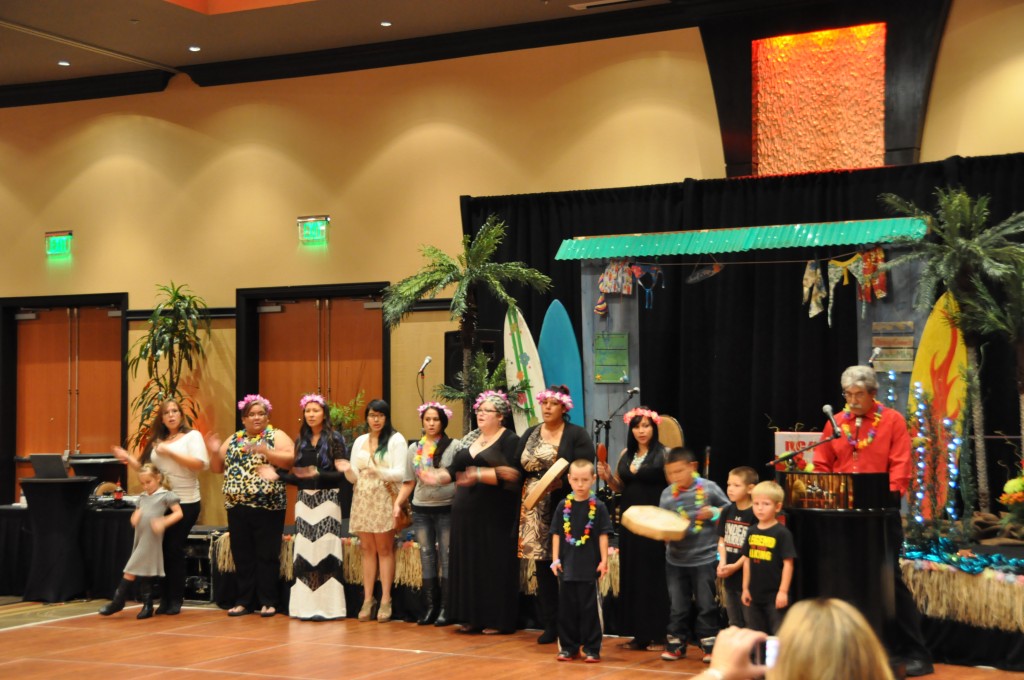
By Monica Brown, Tulalip News writer
TULALIP, WA – Addiction can happen to anyone. It is not something that strikes instantly; it begins as a habit, slowly overtaking the person in a process that can take anywhere from days to years. An addiction starts as a habit that becomes harmful to the person, eventually they reach a threshold where they are no longer in control of their choices but are instead controlled by their habit.
Tulalip celebrated its 34th annual Wellbriety Banquet at the Tulalip Resort’s Orca ballroom on Saturday, Sept 21st. As people arrived and filled the ballroom they greeted one another with hugs, handshakes and laughter. The annual banquet provides an occasion for tribal members to come together and recognize each other’s challenges as they overcome addiction.
The language department opened the event by greeting everyone with a welcome song sung in Lushootseed. Tribal board member Mel Sheldon started off the evening of speeches by thanking everyone for being there and invited the tribal members that had been asked to speak to come to the stage and tell their story about addiction and recovery.
Katie Jones told her story of addiction, recovery and how it has affected not only her life but her children’s lives. “Our addiction takes over; when they say “It’s becoming you” they’re not lying. It becomes your best friend,” said Katie. She is now part of many support groups and helps others stay on the path to recovery. She is also beginning a program which will help guide parents through the system to help them get custody of their children back.
Rudy Madrigal is now a legitimate, successful business man. He explained how his addiction was different in a way that it wasn’t all about substance abuse, “I bring a different type of addiction; I was addicted to money.” Rudy admitted how he remembers selling to many of the people in the room. “Addiction is where you lose your family; you lose everything. I even lost my reservation. I was excluded from this reservation for what I did.”
The stories are upsetting to listen to but they have an ending that gives hope to others struggling with their addiction. When Board member Deborah Parker was asked to speak, she explained how when people share their stories of hurt or anger, how important it is to cleanse yourself off so you aren’t carrying the hurt or anger around with you.
Deborah said, “In a teaching an elder gave me this week, “He said to make sure you wash yourself with water, wherever you go.” You can go to the river; you can go to the bay. Go, be next to the water. Even if you don’t have time for that, when you wash yourself off in the morning, make sure you take that water and you cleanse yourself and ask for something for yourself, maybe it’s healing or to release some anger or hurt you have in your heart.”
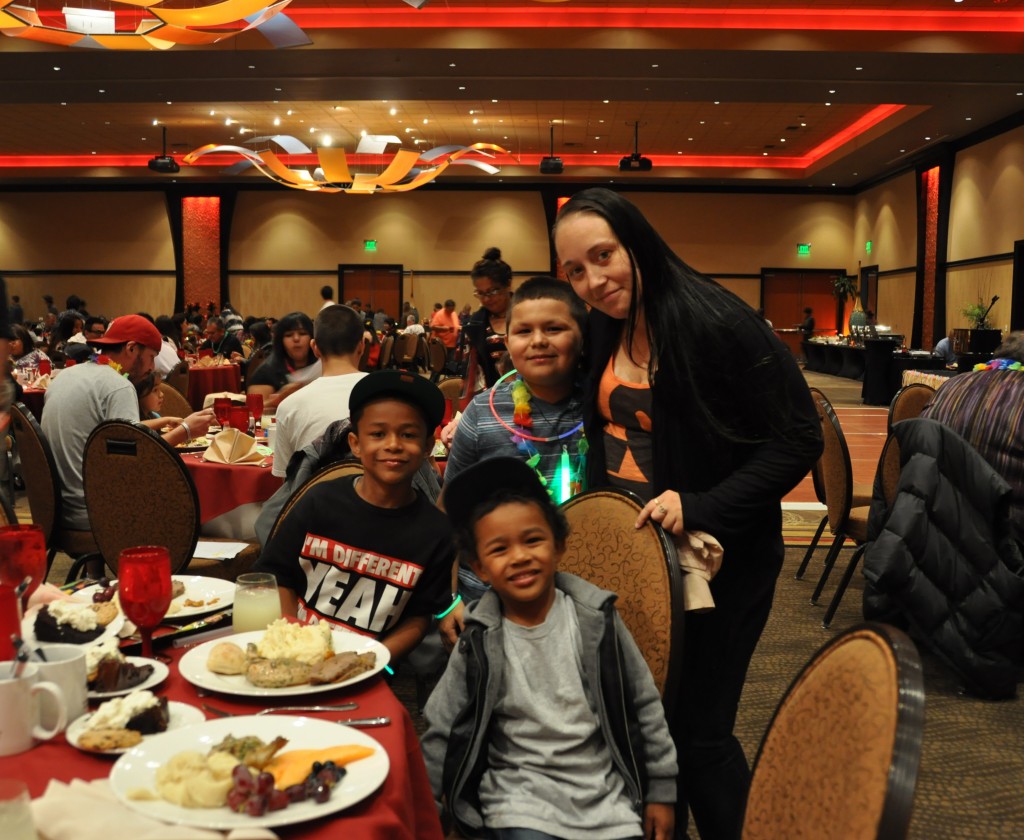 Before the live entertainment and dancing would start they began the sobriety countdown. As the 40 year countdown went on, throughout the room as people stood to declare how long they had been clean and sober it was made evident that quite a few attendees have been enjoying the Wellbriety banquets for many years.
Before the live entertainment and dancing would start they began the sobriety countdown. As the 40 year countdown went on, throughout the room as people stood to declare how long they had been clean and sober it was made evident that quite a few attendees have been enjoying the Wellbriety banquets for many years.
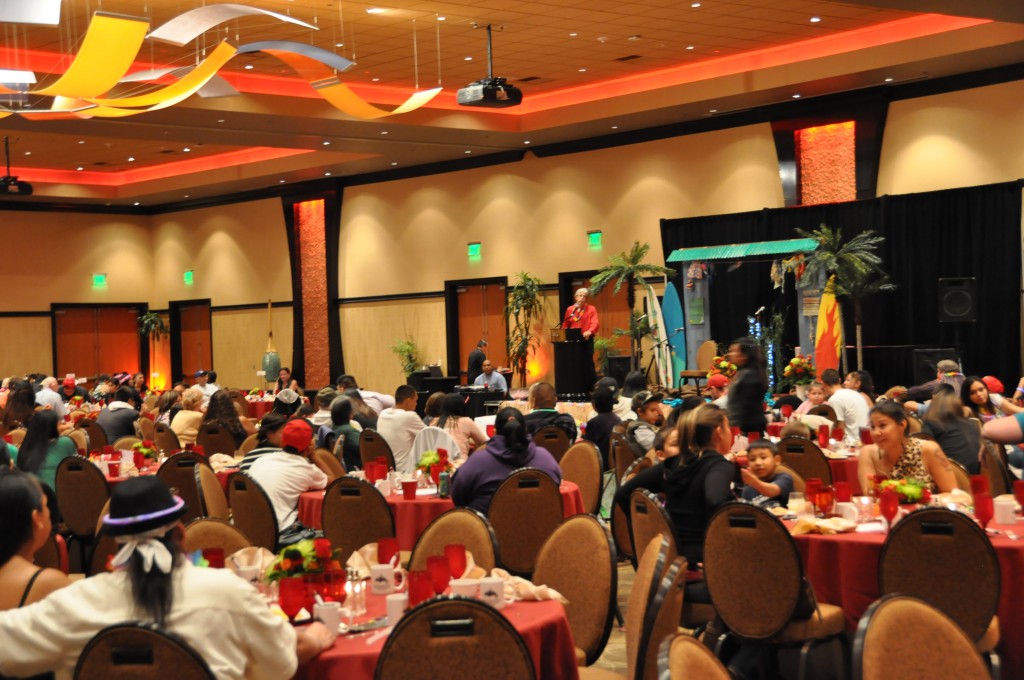
Richard Walker, Indian Country Today Media Network
This was James “Smitty” Hillaire’s debut as a stage actor, and yet he emoted anger, frustration and pain like a pro.
“We don’t like to call it acting,” Hillaire said. “We’re trying to tell a story, a story that hasn’t been told … A lot of people didn’t realize why we’re still fighting for our rights today. It’s still going on.”
Hillaire portrays Chowitshoot, a leader of the Lummi people and a reluctant signer of the 1855 Treaty of Point Elliott in “What About Those Promises?”, a stage production about treaty promises that have not been fulfilled by the United States.
To develop the script, Shelly Muzzy pored through transcripts of proceedings stored at the University of Washington. The audience is confronted with a true version of history not like those found in many textbooks.

Here, Chowitshoot and other Lummi representatives raise concerns about how the treaty will affect their rights to fish, hunt, harvest, and continue their way of life. Chief Si’ahl, or Seattle, leader of the Duwamish and Suquamish peoples, urges his peers to not sign the treaty.
The treaty was signed under duress, Hillaire said. “Sign or walk knee deep in blood—those were the words. We had no choice. We were forced to sign.”
The play brings to life the ongoing struggles of the Lummi people to see the promises of the treaty fulfilled, and gives voice to the people involved in those struggles.
The scenes take place when the United States was in the “fever of the termination era” and terminating its treaty responsibilities owed to tribes, Jewell James wrote in Whatcom Watch; he is director of the Lummi Nation’s Sovereignty and Treaty Protection Office. The region’s First People were jailed for trying to fish and harvest in their traditional grounds, as promised in Article 5 of the treaty; their rights to fish and harvest were upheld in 1974 in the U.S. District Court case, U.S. v. Washington, also known as the Boldt decision.
“What About Those Promises?” also reveals to the audience the emotional toll the post-treaty years have had—the residential schools, the termination era, and the continuing fight to protect rights, the environment and sacred places.
“We’ve been treated like animals, actually,” Hillaire said. “I believe we are one of the most regulated people in the whole country. We’re treated like prisoners of war; we’ve never gone to war [against the U.S.], we never surrendered either, but they treat us like a conquered people.”

Hillaire and his wife, Lutie, who also has a role in the play, have been participating in workshops to help them deal with the emotional impacts of historical trauma.
“I have a difficult time right off trying to deal with the anger,” he said. “I have kind of mixed emotions—some of it anger, some of it sadness.”
What producer Darrell Hillaire hopes people take away from his play: “That their word is good. Anybody. All people. All cultures. To keep our word to one another. We have such diverse peoples living in this country, in our communities. How do we best learn to live together? Well, you keep your promises first. From there, you learn to live together.”
State Rep. John McCoy, D-Tulalip, one of two Native Americans in the state House of Representatives, authored laws that require the history and culture of Washington’s First Peoples is taught in the state’s public schools, and allow tribes to open their own schools and create their own curriculum.
“This would be a great production to be out there [in schools],” he said. “You bring in your youngsters and your current leadership and your elders, and then do this production. If every tribe would do that, we’d really educate the state of Washington.”
He added, “Youngsters, you have to listen—listen to the stories of the elders, so we know where we’ve been, so you know where to go.”
The next staging of the production will be October 18 at Seattle University’s Pigott Hall at 7:30 p.m. Tickets are available at BrownPaperTickets.com.
Read more at http://indiancountrytodaymedianetwork.com/2013/09/23/failed-treaty-point-elliott-promises-spotlighted-play-151321